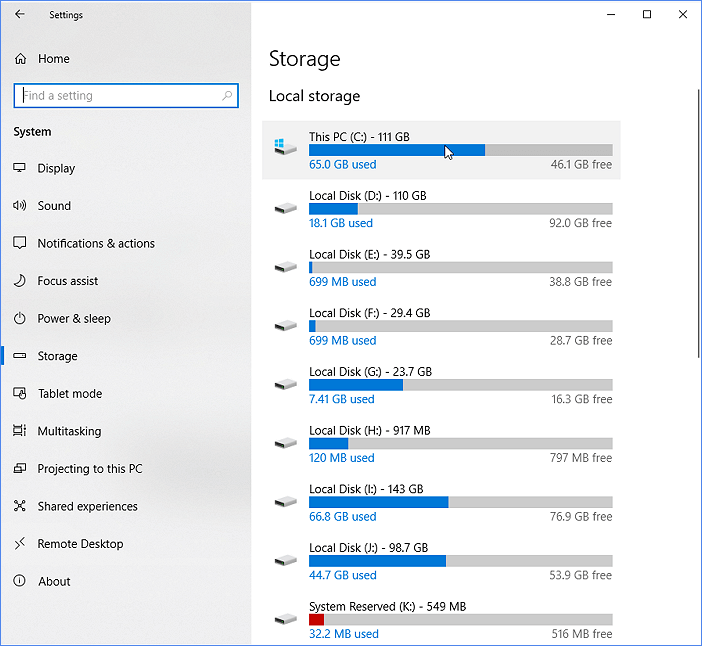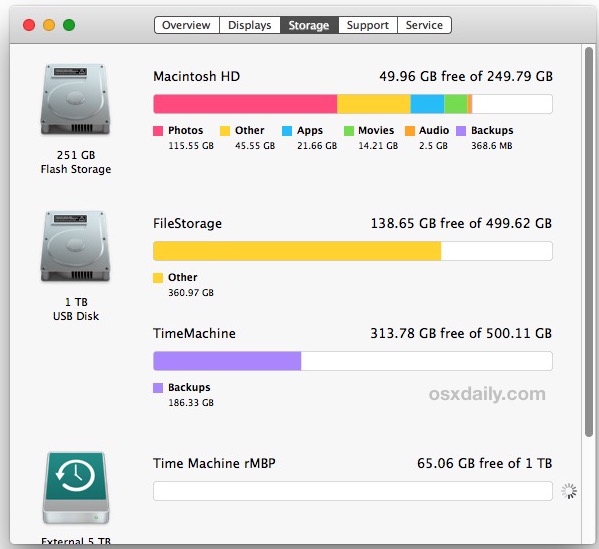Mac Os Free Up Space On Hard Drive

- Mac Os Free Up Space On Hard Drive Windows 10
- Free Up Space On My Hard Drive Mac
- Mac Free Up Space On Hard Drive
Oct 26, 2014 Hard Drive Space Mysteriously Filling Up MacBook OX 10.5 by armwood Aug 14, 2009 11:51AM PDT One day I had 8gb free the next day it was full and I did not add any files. Apr 30, 2020 This would be a sure short disaster, which is why you should be ensuring a complete updated backup of the Mac hard drive running OS X El Capitan. 10.11 or to reclaim Mac hard drive spaces, remove junk files, etc. Try Mac cleaner software which is available free. Nov 05, 2015 This is a short tutorial on how to free up space on your mac's hard drive. Find hidden files that are taking up a ton of space and you didn't even know! Brave Browser Download: https://brave.com.
Mar 13, 2018 Hard drives are getting larger and larger, but somehow they always seem to fill up. This is even more true if you’re using a solid-state drive (SSD), which offers much less hard drive space than traditional mechanical hard drives. RELATED: 10 Ways To Free Up Disk Space on Your Mac Hard Drive. If you’re hurting for hard drive space, these. Mar 31, 2020 They also, eventually, start taking up noticeable space on your hard drive. Get an iPhone SE with Mint Mobile service for $30/mo. The program will then continue to replace the old snapshot with a new one until you free up space on your Mac's internal storage, at which point it will go back to saving weekly snapshots as long as space permits.
You won’t regret cleaning pools of junk files from OS X El Capitan since cleaning Mac hard drive is a prolific activity and basic start of Mac optimization. However, if you look deeper into OS X El Capitan disk you will actually find difficult to identify between useful and junk files. Since looking and identifying junk files is confusing you might end up removing important files. This would be a sure short disaster, which is why you should be ensuring a complete updated backup of the Mac hard drive running OS X El Capitan. 10.11 or to reclaim Mac hard drive spaces, remove junk files, etc. try Mac cleaner software which is available free.
Before you launch cleaning operation on Mac OS X El Capitan, right-click on the Time Machine icon from top – left of the menu bar and select BACK UP NOW. Wait for some-time so that Time Machine application performs full backup of your OS X El Capitan hard drive.

Now gather your strength and start Mac cleaning with.

Emptying Trash on OS X El Capitan
You know by pressing “Command + Shift + Option + Delete” keys, you can clean out all the files from the Trash without the use of mouse and its right click. This is helpful when you are sure that no important files exist to be resorted back from the trash. Otherwise manually take a tour of your trash folder so that you can restore important files back to their location and proceed with permanent deletion of files from the trash.
Which of the above trash looks cleaner and better on El Capitan? You decide.
Clean all unwanted files from Download folder
You might be busy in downloading the best Mac apps or videos for OS X El Capitan but did you remember to move all the used DMG and zip archive files to trash? Go to the Download folder and press-hold “Command + I” to get info of Download folder. No surprises, if you are surprised to check out the Size of the folder due to presence of unwanted files. Don’t spare a minute to send all of them to Trash and do empty it for free space collection.
Cleaning iTunes duplicate files
Music files can easily get duplicated in iTunes but don’t worry because iTunes can help you find them for removal. It’s very simple, see how: Launch iTunes << Click View << Click ShowDuplicateItems. The iTunes application will list up all the duplicate music files by name, artists or group items. To remove the duplicate files from the hard drive you first need to uncheck the original files and keep checked all the duplicate items. Now click on Edit from iTunes menu bar and click Delete. This is how to you says GOODBYE to duplicate files on iTunes using OS X El Capitan or below versions.
Let me share with you that there is an otherwise better solution to remove iTunes, iPhoto, iMovies, iWork and Aperture duplicate files by using Smart Finder application. Though small, it’s a helpful application that eliminates all kinds of duplicate files from OS X.
Cleans caches safely from El Capitan
There are pros and cons of removing old & news caches from Mac hard drive. The plus part is that your Mac OS X gets good amount of hard drive spaces by removal of large stockpile of caches. If your Mac hard drive is dying on free spaces, giving you hiccups or freezing at the best part of your OS X computing then you shall always go ahead to clean this culprit knows by the name – CACHES. Additionally, when your Mac hard drive have good amount of free spaces it will never ever disappoint you with the error message “Your startup disk is almost full” You need to make more space available on your startup disk by deleting files.
My recommendation is to register Stellar Speedup Mac utility for cleaning out caches from the OS X El Capitan home folder. This tool reaches to the deeper location of the hard drive where mouse cursor may not reach. Run this tool now and you will clean all the junks (including logs, unwanted language files, binaries, extensions and system junks) from the hard drive. After the use of Stellar Speedup Mac software all you will be left with a better and faster OS X El Capitan.
Coming back to the minus part of deleting the caches is some of the OS X apps, mostly browsers may behave slower than before. But don’t worry since creation of new and fresh caches will soon fill up the void.
Uninstalling useless application
Mac hard drive cleaning is incomplete without uninstallation of unwanted freeware, shareware, widgets and plugins. Show your Mac OS X that you care for its cleanliness and remove all sorts of useless and unused software to a location they deserve the most i.e. TRASH. Let me also remind you again to empty the trash.
Backup Mac OS X and fresh install OS X
Some misery of slowness never ends which is why you should go for fresh installation of the OS X El Capitan. Though technical, but simple procedure of cleaning an old copy of sluggish and freezing Mac and replacing it with new one. This post best describes the clean installation of OS X El Capitan. Be prepared for an OS X performance evolution and leave me your thoughts.
Having to play around with large video files can be a headache when my system has a blazingly fast SSD drive but is only 500GB in size. Going to the macOS storage analyzer can be a mixed bag of easy to understand actions to reduce disk usage to cryptic descriptions that are more daunting to deal with.
Mac Os Free Up Space On Hard Drive Windows 10
We have spoken about how to rid your computer from data noted in 'other' which in short is space taken up by caches, plug-ins, and documents. But now we'll show you how to reclaim some of your disk space from your 'System' disk usage.
Time Machine and local backups
If you run Time Machine for backups over Wi-Fi like I do, then macOS High Sierra will simultaneous use your remote backup disk and your local disk to save backups to. The reasoning behind this is that in the event the remote backup disk is not available or present, then you can recover files in spite of a missing remote backup disk and recover from the local disk.
In fact, macOS High Sierra manages this disk usage seamlessly without user intervention. It also purges local backups if disk space starts to get too low. However, sometimes the purging doesn't happen to leave enough disk storage for my very large video files and I'll get a 'not enough disk space' message. And instead of waiting for macOS to catch up with my disk space requirements, I can force the purging from the terminal.
Determining if you have a large amount of 'System' disk usage
To see if this method will help you reclaim some disk space we need to check the macOS System Information.
- Click the from your desktop.
- Click About This Mac.
Click the Storage tab. You'll be greeted with a color-coded categorization of what your disk is being used for.
In my case, 'System' (meaning the operating system) was clearly using the most space. Although I understand the reasoning behind why Time Machine is storing local backups, I didn't feel that I needed so much of my disk space devoted to these local backup snapshots.
If you have other categories that have very high disk usage you can click the manage button to get more details on what is using that disk space and possibly delete those things that you determine to no longer have use for.
Purging local backups
Please note that although this doesn't affect your remote backup from Time Machine, this will get rid of the redundancy (at least until the next Time Machine backup) that a local backup disk will provide. If you need such redundancy or are worried about the recovery of your data then you would be best served to let macOS determine when to purge these files.
- Start Terminal from spotlight.
- At the terminal type tmutil listlocalsnapshotdates.
Hit enter.
Here, you'll now see a list of all of the locally stored Time Machine backup snapshots stored on your disk.
Next you can remove the snapshots based on their date. I prefer to delete them one at at time. Once my 'System' disk usage is at an acceptable level, I stop deleting but you can delete all of them if you want to reclaim all of the disk space.
- Back at the terminal, type tmutil deletelocalsnapshots where
will be one of the dates from your backup. This will be in the form of xxx-yy-zz-abcdef. Try to start with the oldest snapshot. - Hit enter.
Repeat for as many snapshot dates as required.
Free Up Space On My Hard Drive Mac
You can watch your System Information graphic free up disk space in real time to see if you've removed enough.
I want to stress that this should only likely be used if you absolutely immediately need to reclaim the disk space. Otherwise macOS does a pretty good job in managing the unused disk space for local backups and purging when it deems necessary.
Are you running out of disk space? What have you done about it? Let us know in the comments!
We may earn a commission for purchases using our links. Learn more.
exposure notificationNational COVID-19 server to use Apple and Google's API, hosted by Microsoft
Mac Free Up Space On Hard Drive
The Association of Public Health Laboratories has announced it is working with Apple, Google, and Microsoft to launch a national server that will securely store COVID-19 exposure notification data.